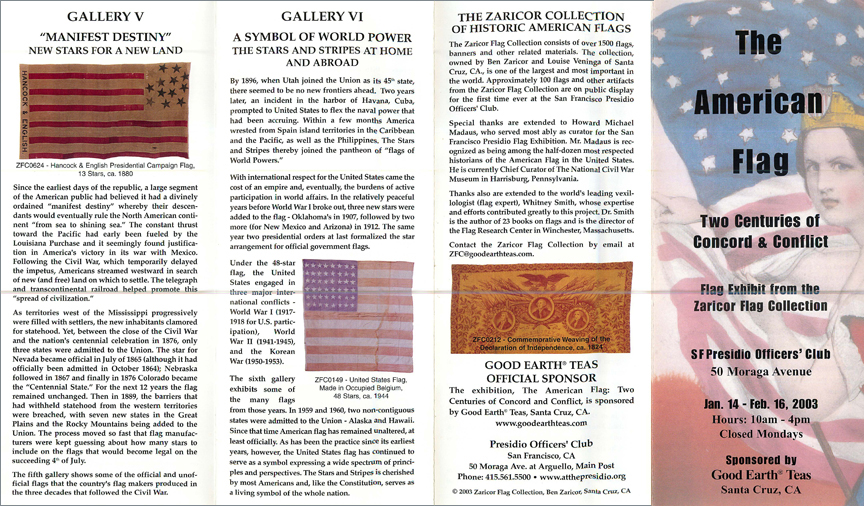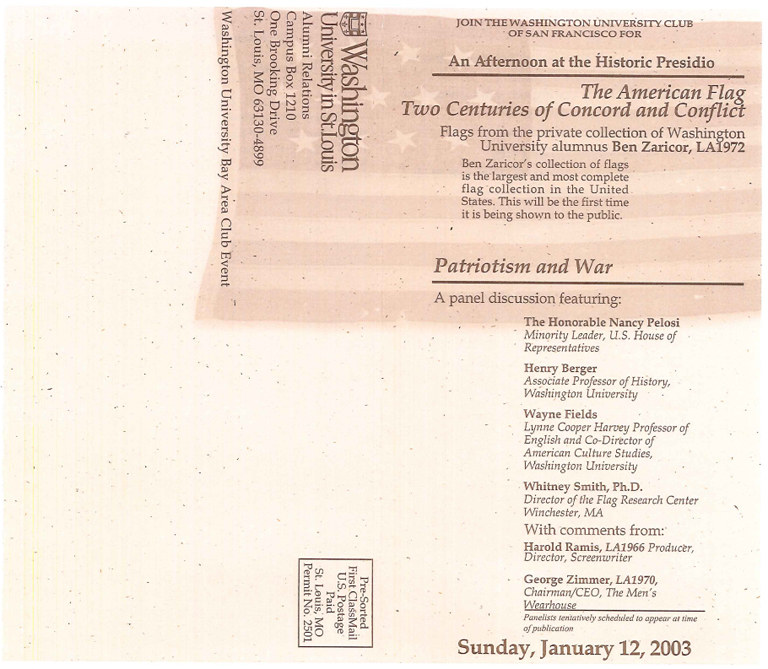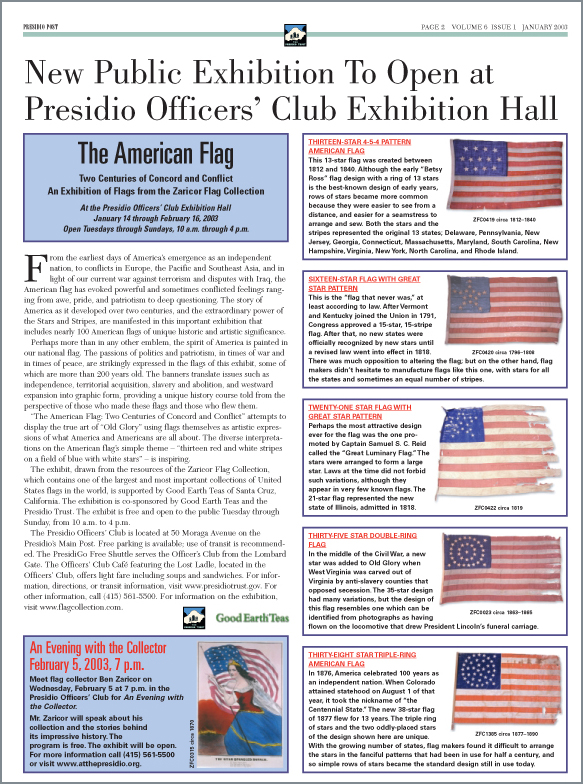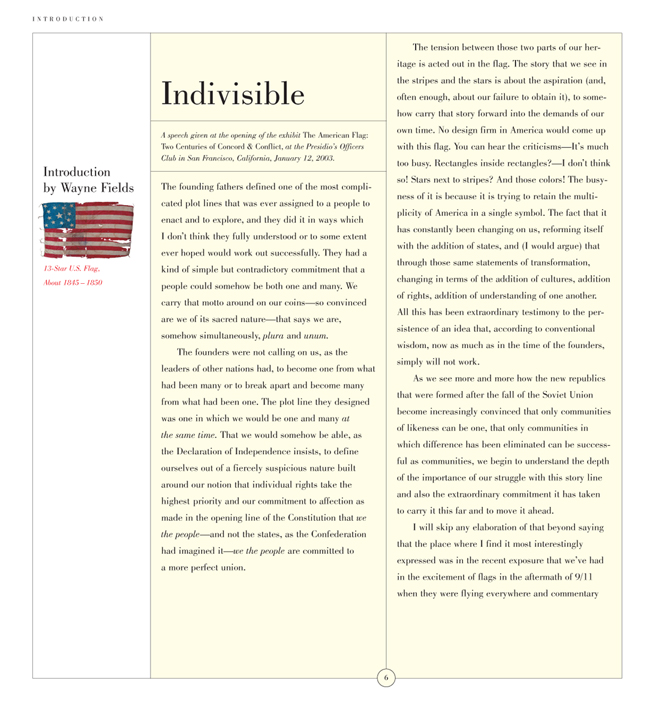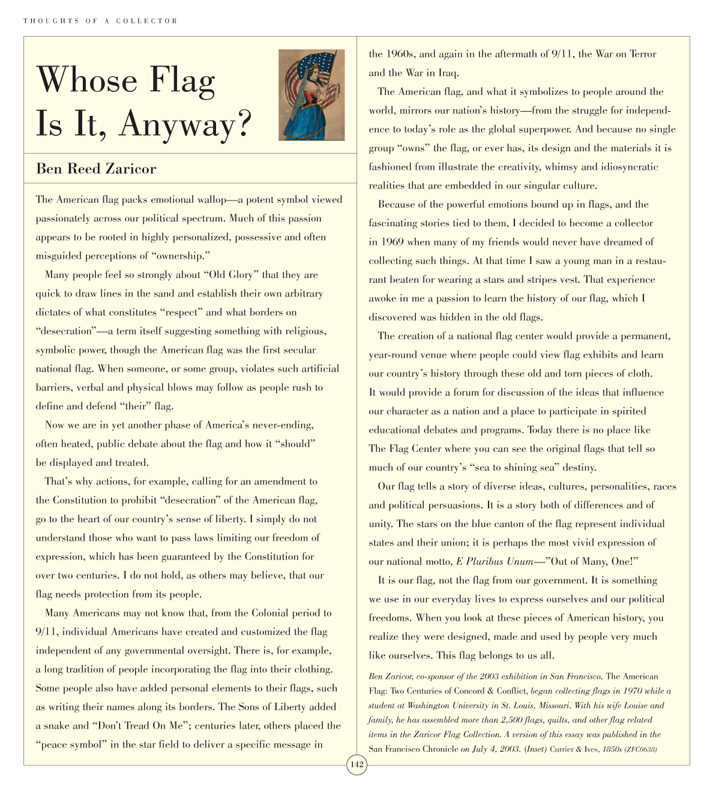First Presidio Exhibit, 2003

The American Flag: Two Centuries of Concord & Conflict
Exhibit Opened Memorial Day 2003 in San Francisco's Presidio
Click for a Slideshow of the Exhibited Flags
Exhibit of Historic American Flags, Quilts and Related Memorabilia
On View in San Francisco's Presidio

SAN FRANCISCO: An unprecedented exhibition of more than 100 flags, quilts and
flag-related memorabilia from three of the most important private collections in the
world opened Memorial Day in San Francisco's Presidio. On view through July 31,
2003, The American Flag: Two Centuries of Concord and Conflict presents two hundred
years of U.S. history as illustrated through the evolution of the nation's most recognizable
symbol.
Featuring works of art dating from the early Federalist Period through modern
times, the exhibit is drawn from the Zaricor Flag Collection of over 1,500 flags and
related items through the 32-year effort of Ben Zaricor, founder of Good Earth Teas.
The collection has been called a "national treasure" and a "world-class exhibit" by
Congressman Mike Honda and The Presidio Trust. The 100 flags in the exhibit are
complemented by historical hand-sewn American quilts from the collection of Louise
Veninga, co-founder of Good Earth Teas; and a variety of Stars and Stripes memorabilia
from the acclaimed collection of San Francisco graphic designer Kit Hinrichs.
"There is no museum in the U.S. dedicated exclusively to flags, and none with
this range and quality," according to Dr. Whitney Smith, the world flag expert of
Winchester, Massachusetts. "By presenting the history of America as seen through its
original flags, our goal is to encourage visitors to examine and discuss why this 18th
century symbol remains so relevant into the 21st century."
There are nearly three dozen star designs of the U.S. flag on exhibit.
Incorporating a diverse variety of designs, fabrics, and symbol variations, the flags
paint a picture of America from the revolution period through the recent conflict in
Afghanistan. Examples include one of the nation's very earliest 13-Stars and 13-
Stripes circa 1800; a priceless 21-star "Great Luminary" dating from 1819; an array of
flags used by Union forces during the Civil War; and a gallery of original U.S. flags representative
of American military power throughout the 20th century, including the first
American flag to drop anchor in Japanese waters during WWII and the English White
Ensign from the lead ship of D-Day. There is also a perfect example of a 33-star
American flag, representing one of California's earliest flags; and a 48-star U.S. flag
handcrafted from bed sheets by a Belgium family and displayed during their liberation
by WWII troops. There are many more.
"This exhibit marks only the third time in U.S. history that the American flag has
been exhibited using original flags to tell the story of our country's history," Zaricor
said. "We hope this exhibit will generate interest among the people of America to support
a foundation for the establishment of a permanent Flag Center in San Francisco at
the Presidio. The Center would showcase and interpret the many significant flags that
exist in private collections for the education of our children and others interested in the
relevance to our everyday life."
The American Flag: Two Centuries of Concord and Conflict is sponsored by
Good Earth Teas, Pentagram and The Presidio Trust. The exhibit will be on view
through Thursday, July 31, 2003 at The Presidio Officers' Club, 50 Moraga Avenue
(Arquello Gate), in the Presidio, San Francisco. Gallery hours are 10:00 a.m. - 5:00
p.m. Thursday - Sunday, 10:00 a.m. - 8:00 p.m. Wednesday (Closed Monday &
Tuesday except Memorial Day).
Admission to the exhibit is FREE. Visitor information is available at 415/561-
5500 or www.atthepresidio.org
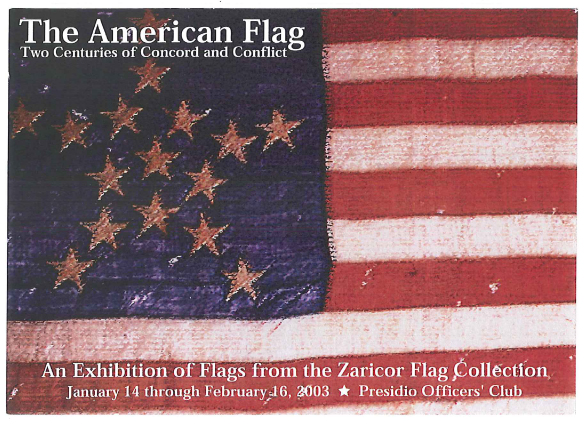
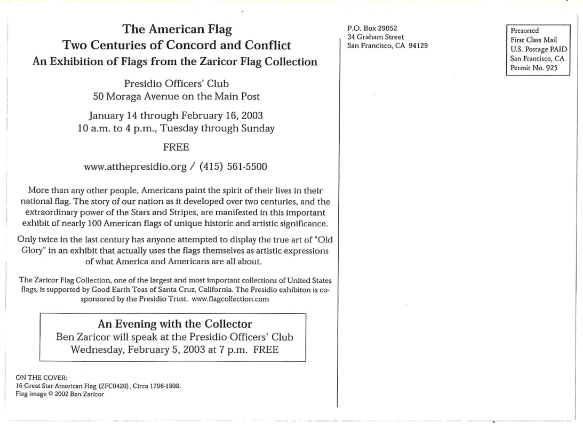
The American Flag: Two Centuries of Concord & Conflict. Click on the page below to view the exhibit brochure.
The American Flag: List of Flags. Click on the page below to view the complete list of flags from the exhibit.
PATRIOTISM AND WAR: KEYNOTE SPEAKERS and Q&A
Click on the page below to view the panel discussion brochure.

"Patriotism and War" Keynote Speakers - Reel 1
Click on the audio player below to listen to the Northern California Alumni Event & Grand Opening speeches at The American Flag: Two Centuries of Concord & Conflict Exhibit.
"Patriotism and War" Keynote Speakers - Reel 2
Click on the audio player below to listen to the second part of the Northern California Alumni Event & Grand Opening speeches at The American Flag: Two Centuries of Concord & Conflict Exhibit.
"Patriotism and War" Questions and Answers
Click on the audio player below to listen to the Q&A part of the Northern California Alumni Event & Grand Opening speeches at The American Flag: Two Centuries of Concord & Conflict Exhibit.
Rep. Mike Honda and Howard Madaus, Curator Flag Center, Alumni of Washington University St. Louis, Opening Event, January 12, 2003.
NEWS COVERAGE
Daughters of the American Revolution: A Grand Old Obsession. Click on the page below to read the full article.
Copyright 2003 Daughters of the American Revolution. All rights reserved.
Presidio Post: Volume 6 Issue 1 January 2003. Click on the page below to read the exhibit article.
Copyright 2003 The Presidio Trust. All rights reserved.
The American Flag Exhibit Guest Book Click on the page below to read excerpts from guest comments about the flag exhibit.


INDIVISIBLE Click on the page below to read a speech by Wayne Fields given at the opening of the exhibit The American Flag: Two Centuries of Concord & Conflict on January 12, 2003 and included in the book by the same title.
Click here to order the book from our online store.
Copyright 2006 by Veninga-Zaricor Publications. All rights reserved.

War & Patriotism
Henry Berger
Remarks Prof. Berger made at the Presidio in San Francisco on the occasion of the opening of the American Flag Exhibit in January 12, 2003.
Patriotic language and symbols, in the words of historian Harry Fulmer, can be drafted "into the service of manifestly unjust causes." But patriotism, like many ideas worth talking about, is a double-edged sword. Patriotism can also be - and has also been - summoned to validate, rededicate, and recommit a national community to the values and principles on which the country has been becoming established. I say "has been becoming" established because I view it as a work in progress.
The labor, the effort, the sacrifice on behalf of liberty, justice, and equality was not finished at Independence in 1776 - nay, barely begun. Nor completed in 1865 with the abolition of slavery or climaxed in 1892 when the Pledge of Allegiance was written by Christian socialist Francis Bellamy, first cousin of Edward Bellamy, well-known author of the novel Looking Backward. Nor was the task finished in 1917 when America went to war, allegedly (and hopefully) to "make the world safe for democracy." Nor when William Tyler Page crafted the American Creed to educate the millions of immigrants who had come to America during the previous three decades - those immigrants who, among others, built the industrial capitalist order which made America by 1919 a great world power. The promise was not yet realized for workers who labored and fought for decent lives and recognition of their communal rights in the great labor struggles of the 1930s and the 1940s. Nor even finished with the accomplishments of the civil rights movements of the 1960s.
And surely not yet in our own time, when civil liberties embodied in the Constitution are being abridged - not for the first time in our history - in the name of security and when declarations of triumphalism and exceptionalism are heard in the land in the name of patriotic allegiance, when some Americans - knowing that we are the sole reigning world superpower - would display such hubris, dare we ask at this moment of crisis, in this war that we now face - may we ask with Matthew of the New Testament, "What shall it profit us if we shall gain the whole world and lose our own soul?"
The work of patriotic fulfillment as I am defining it is a continuing project. It is not static. It is not finished, nor probably will it ever be, nor should it ever be, so long as the promise of its values of freedom, justice, and equality for all is not served or is ill-served. Long ago a champion of equality, Charles Sumner of Massachusetts, reminded the country of this in an address in 1867 entitled "Are We a Nation?" at a time when the North and the South had only recently ended the carnage of civil war and were in the throes of the conflicted era of Reconstruction. He argued that the standards of patriotism to which Americans should aspire were high. Referring specifically to the flag and its stripes as the representation of patriotic virtue, he intoned: "White is for purity, red is for valor, but above all else blue is for justice. Whatever is done to advance these principles and to strengthen the Constitution as amended is patriotic. Whatever does not, diminishes and sullies the patriotic soul of the people - all the people."
A call to arms tends to distort and to simplify patriotic commitment. This was a flaw well recognized by John Quincy Adams, arguably America's greatest Secretary of State, in 1847 when the ex-President, then Congressman from Massachusetts, argued and acted against slavery and denounced what he believed was an unjust war against Mexico. Alluding to Stephen Decatur's toast in 1816 - "Our country:...may she always be in the right; but our country, right or wrong" - Adams sternly replied in his contrarian fashion, "Say not thou 'my country right or wrong' nor shed thy blood for an unhallowed cause."
We live in alarming and uncertain times. The nation would be ill-served if we did not scrutinize with the utmost care that which we are ignoring at home and abroad and doing so in the name of patriotism and the flag which represents it. Many, perhaps most of us, pledge allegiance to the flag. In 1965, in the midst of the black freedom struggle of that era, novelist and essayist James Baldwin asked, "Has the flag pledged allegiance to you? To all Americans?" As you tour this fine and exquisite exhibit of American flag history you might think about that and also these words about the flag and its patriotic meaning written by Henry Ward Beecher, brother of Harriet Beecher Stowe, in another moment of patriotic crisis: "A thoughtful mind when it sees a nation's flag sees not a flag only but the nation itself and whatever may be its symbols, its insignia, one reads chiefly in the flag the government, the principles, the truths, the history, which belong to the nation that sets it forth." The history, I might suggest, is for us - for all of us - to determine and to make it good and just for us, all of us, so that about the country and its flag we can rightfully raise our voices and joyously proclaim, as Marian Anderson sang it many years ago at the Lincoln Memorial, "Of thee we sing."
Henry Berger is Emeritus Professor of History at Washington University in Saint Louis, where he taught for thirty-five years before retiring June 30, 2005. Prior to that time he was also a member of the History Department at the University of Vermont for five years. Professor Berger taught and has written about American foreign relations and about discontent, dissent, and protest in America in the Twentieth Century. He is also the editor of A William Appleman Williams Reader (1994).
Whose Flag Is It, Anyway? Click on the page below to read the essay by Ben Zaricor included in the book The American Flag: Two Centuries of Concord & Conflict and a version published in the San Francisco Chronicle on July 4, 2003.
Click here to order the book from our online store.
Copyright 2006 by Veninga-Zaricor Publications. All rights reserved.
The labor, the effort, the sacrifice on behalf of liberty, justice, and equality was not finished at Independence in 1776 - nay, barely begun. Nor completed in 1865 with the abolition of slavery or climaxed in 1892 when the Pledge of Allegiance was written by Christian socialist Francis Bellamy, first cousin of Edward Bellamy, well-known author of the novel Looking Backward. Nor was the task finished in 1917 when America went to war, allegedly (and hopefully) to "make the world safe for democracy." Nor when William Tyler Page crafted the American Creed to educate the millions of immigrants who had come to America during the previous three decades - those immigrants who, among others, built the industrial capitalist order which made America by 1919 a great world power. The promise was not yet realized for workers who labored and fought for decent lives and recognition of their communal rights in the great labor struggles of the 1930s and the 1940s. Nor even finished with the accomplishments of the civil rights movements of the 1960s.
And surely not yet in our own time, when civil liberties embodied in the Constitution are being abridged - not for the first time in our history - in the name of security and when declarations of triumphalism and exceptionalism are heard in the land in the name of patriotic allegiance, when some Americans - knowing that we are the sole reigning world superpower - would display such hubris, dare we ask at this moment of crisis, in this war that we now face - may we ask with Matthew of the New Testament, "What shall it profit us if we shall gain the whole world and lose our own soul?"
The work of patriotic fulfillment as I am defining it is a continuing project. It is not static. It is not finished, nor probably will it ever be, nor should it ever be, so long as the promise of its values of freedom, justice, and equality for all is not served or is ill-served. Long ago a champion of equality, Charles Sumner of Massachusetts, reminded the country of this in an address in 1867 entitled "Are We a Nation?" at a time when the North and the South had only recently ended the carnage of civil war and were in the throes of the conflicted era of Reconstruction. He argued that the standards of patriotism to which Americans should aspire were high. Referring specifically to the flag and its stripes as the representation of patriotic virtue, he intoned: "White is for purity, red is for valor, but above all else blue is for justice. Whatever is done to advance these principles and to strengthen the Constitution as amended is patriotic. Whatever does not, diminishes and sullies the patriotic soul of the people - all the people."
A call to arms tends to distort and to simplify patriotic commitment. This was a flaw well recognized by John Quincy Adams, arguably America's greatest Secretary of State, in 1847 when the ex-President, then Congressman from Massachusetts, argued and acted against slavery and denounced what he believed was an unjust war against Mexico. Alluding to Stephen Decatur's toast in 1816 - "Our country:...may she always be in the right; but our country, right or wrong" - Adams sternly replied in his contrarian fashion, "Say not thou 'my country right or wrong' nor shed thy blood for an unhallowed cause."
We live in alarming and uncertain times. The nation would be ill-served if we did not scrutinize with the utmost care that which we are ignoring at home and abroad and doing so in the name of patriotism and the flag which represents it. Many, perhaps most of us, pledge allegiance to the flag. In 1965, in the midst of the black freedom struggle of that era, novelist and essayist James Baldwin asked, "Has the flag pledged allegiance to you? To all Americans?" As you tour this fine and exquisite exhibit of American flag history you might think about that and also these words about the flag and its patriotic meaning written by Henry Ward Beecher, brother of Harriet Beecher Stowe, in another moment of patriotic crisis: "A thoughtful mind when it sees a nation's flag sees not a flag only but the nation itself and whatever may be its symbols, its insignia, one reads chiefly in the flag the government, the principles, the truths, the history, which belong to the nation that sets it forth." The history, I might suggest, is for us - for all of us - to determine and to make it good and just for us, all of us, so that about the country and its flag we can rightfully raise our voices and joyously proclaim, as Marian Anderson sang it many years ago at the Lincoln Memorial, "Of thee we sing."
Henry Berger is Emeritus Professor of History at Washington University in Saint Louis, where he taught for thirty-five years before retiring June 30, 2005. Prior to that time he was also a member of the History Department at the University of Vermont for five years. Professor Berger taught and has written about American foreign relations and about discontent, dissent, and protest in America in the Twentieth Century. He is also the editor of A William Appleman Williams Reader (1994).



